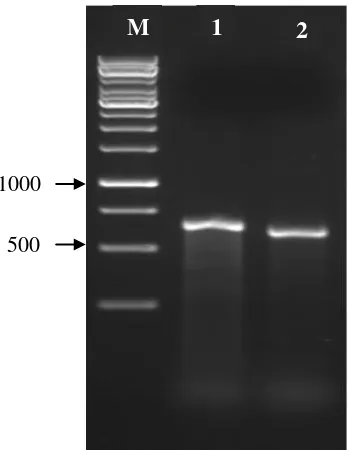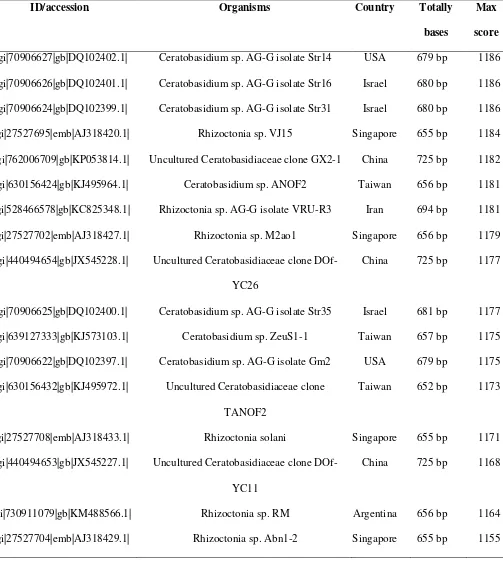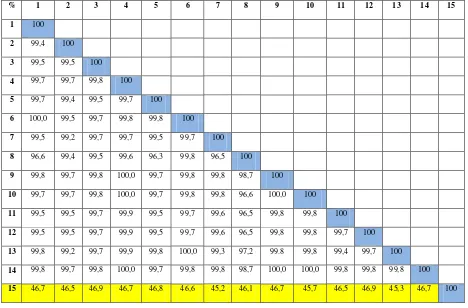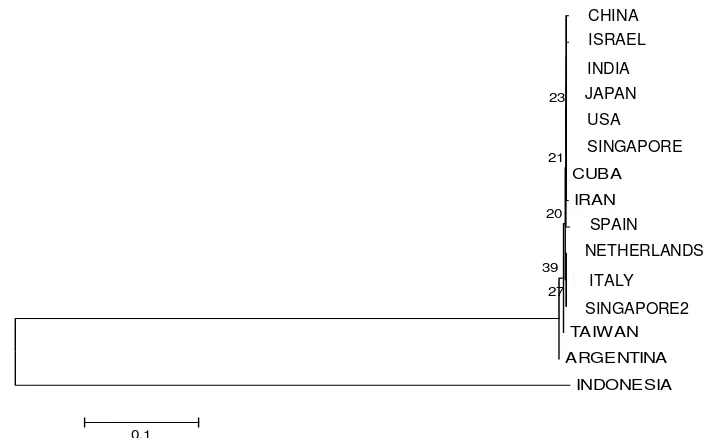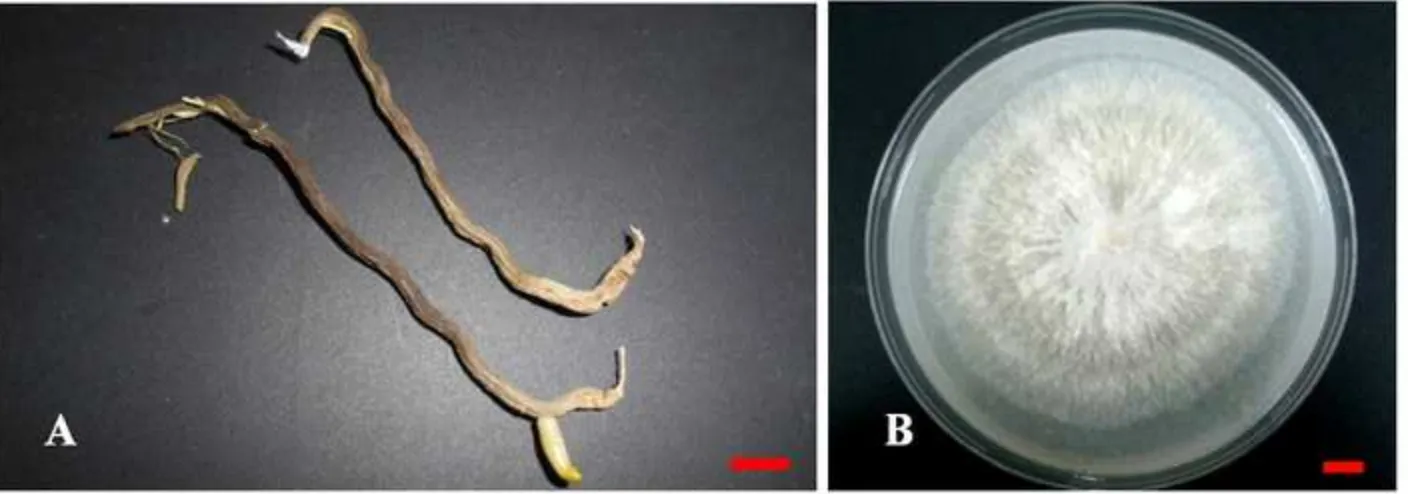Manuscript Draft
Manuscript Number: FUNECO-D-16-00140
Title: MOLECULAR PHYLOGENY OF MYCORRHIZAL RHIZOCTONIA ISOLATED FROM WILD TROPICAL ORCHIDS IN INDONESIA
Article Type: Original Research Paper
Keywords: Rhizoctonia sp.; rDNA-ITS; Phalaenopsis sp.; Orchid Mycorrhizal Fungi
Corresponding Author: Mr. Budi Setiadi Daryono,
Corresponding Author's Institution: Universitas Gadjah Mada
Abstract: Rhizoctonia sp. has an important role as a biocontrol agent. Its association with Phalaenopsis amabilis was molecularly identified through rDNA-ITS sequence analysis, conducted as one of wild orchid conservation efforts in Indonesia. A group of Rhizoctonia sp. were isolated from the root of orchid plant in Yogyakarta. Verification
analysis of these isolates resulted in 600-750 bp DNA products located on the ITS1-5.8S-ITS4 region. The sequenced products showed insertion and substitution occurances, which may result in strain diversity and possible variation in severity. Reconstruction of phylogenetic trees using Maximum Parsimony and Bootstrap-1000 approach showed that
Indonesian isolates have undergone speciation and have been positioned in the cluster, which are already far apart from the other isolates. Results of this study were expected to become the basic information in an effort of wild orchid cultivation and protection against infectious diseases in Indonesia. The study was the first to report regarding Rhizoctonia sp. isolated from wild tropical orchids in Indonesia.
Suggested Reviewers: Kalaivani Nadarajah Universiti Kebangsaan Malaysia
vani@ukm.my Baruch Sneh
Tel Aviv University baruchs@tauex.tau.ac.il Ivor John Hodgkiss
The University of Hong Kong hodgkiss@hkucc.hku.hk
Order of Authors: Mahfut -; %XGL6'DU\RQRAri Indrianto; Susamto Somawiyarjo
Indonesia
Dear Sir/Madam
Editor of Fungal Ecology,
In this paper, we report on phylogenetic analysis of mycorrhizal Rhizoctonia which was isolated from wild Phalaenopsis amabilis L. (Blume) in Indonesia. This is significant because it is the first taxonomic data related to mychorrizal Rhizoctonia from Indonesia. The
Rhizoctonia was separated from other isolates on another countries. The data could be add to the global data of mychorrizal Rhizoctonia. The paper should be of interest to readers in the areas of mycology, plant pathology, and conservation because the mycorrizhal Rhizoctonia has a number of role in environment, one of which is to prevent Odontoglossum ringspot virus and Cymbidium mosaic virus replication.
The potential reviewers from which I wish to be reviewed are :
1. Kalaivani Nadarajah; School of Environmental and Natural Resources Sciences, Faculty of Science and Technology, Universiti Kebangsaan Malaysia, 43600 Bangi Selangor, Malaysia; email: vani@ukm.my
2. Baruch Sneh; Department of Plant Sciences, The George S. Wise Faculty of Life Sciences, Tel Aviv University; email: baruchs@tauex.tau.ac.il
3. I. J. Hodgkiss; Department of Ecology & Biodiversity, The University of Hong Kong, Pokfulam Road, Hong Kong; email: hodgkiss@hkucc.hku.hk
Please address all correspondence concerning this manuscript to me at bs_daryono@yahoo.com. Thank you for your consideration of this manuscript.
0DKIXW
Department of Biology,
Universitas /DPSXQJ,
I wish to submit a new manuscript entitled Molecular Phylogeny of Mycorrhizal
Rhizoctonia Isolated from Nature Tropical Orchids in Indonesia for consideration by the Fungal Ecology. I confirm that this work is original and has not been published elsewhere nor is it currently under consideration for publication elsewhere. I also confirm that this submission for publication has been approved by all of the authors (other than myself),
namely %XGL6HWLDGL'DU\RQR, Ari Indrianto, and Susamto Somawiyarjo.
Sincerely,
0DKIXW
1
MOLECULAR PHYLOGENY OF MYCORRHIZAL RHIZOCTONIA ISOLATED
FROM WILD TROPICAL ORCHIDS IN INDONESIA
1.
2.
3. Laboratory of Biotechnology, Faculty of Biology, Universitas Gadjah Mada, Yogyakarta, 55281,
Indonesia;
4. Laboratory of Plant Virology, Faculty of Agriculture, Universitas Gadjah Mada, Yogyakarta,
55281, Indonesia.
Click here to view linked References
0DKIXW1, %XGL6HWLDGL'DU\RQR2, Ari Indrianto3
, and Susamto Somawiyarjo4
/DERUDWRU\RI%RWDQ\)DFXOW\RI0DWKHPDWLFVDQG1DWXUDO6FLHQFHV8QLYHUVLWDV/DPSXQJ /DPSXQJ,QGRQHVLD
1
Rhizoctonia sp. has an important role as a biocontrol agent. Its association with Phalaenopsis amabilis was molecularly identified through rDNA-ITS sequence analysis, conducted as one of wild orchid conservation efforts in Indonesia. A group of Rhizoctonia sp. were isolated from the root of orchid plant in Yogyakarta. Verification analysis of these isolates resulted in 600-750 bp DNA
products located on the ITS1-5.8S-ITS4 region. The sequenced products showed insertion and
substitution occurances, which may result in strain diversity and possible variation in severity.
Reconstruction of phylogenetic trees using Maximum Parsimony and Bootstrap-1000 approach showed
that Indonesian isolates have undergone speciation and have been positioned in the cluster, which are
already far apart from the other isolates. Results of this study were expected to become the basic
information in an effort of wild orchid cultivation and protection against infectious diseases in
Indonesia. The study was the first to report regarding Rhizoctonia sp. isolated from wild tropical orchids in Indonesia.
2
Phalaenopsis is a genus of orchids, which some of its members have important role as parent crosses (Sarwono, 2002). Approximately 30 of the total 62 species are spread throughout Indonesia.
The presence of this genus in its native habitat (nature) has been reported to have greatly diminished,
even some of the members have been recorded to the IUCN red list version 2013.2 (IUCN, 2013) due
to excessive exploration and forest degradation (Johanis et al., 2001). Thus, it is very necessary to
conserve the existence of wild Phalaenopsis orchids in Indonesia through the efforts of preservation and protection of plants.
Infections by bacteria, fungi, and viruses are still major obstacles in conducting cultivation and
development of wild orchids in Indonesia (Aruni et al., 2011). Cultivating and protecting Phalaenopsis
sp. against diseases in Indonesia could be done through the induction of endophytic microorganisms
(Tanawy, 2009), which includes the Orchid Mycorrhizal Fungi (OMF). Endophytic microorganisms are
biological agents that can prevent and reduce the severity of disease caused by infectious pathogens by
producing enzymes and secondary metabolites that are antagonistic (Harish et al., 2008), which in
addition can also help the growth and development of plants. One type of OMF which have been
isolated and identified is Rhizoctonia sp. (Suryantini, 2015).
Rhizoctonia solani could induce the resistance of Phalaenopsis sp. against infections by
Erwinia chrysanthemi causing soft root disease (Wu et al., 2010), fungal infection by Fusarium sp. causing rotten stems, leaves, and shoots, as well as inhibit the replication Odontoglossum ringspot virus
2
provision of nutrients for growth and development of plantlets (Moreno, et al., 2000; Wu et al., 2011),
and in helping the establishment of more buds and flowers (Moreno, et al., 2000). In this research, the
identification of Rhizoctonia solani was molecularly conducted through analysis of rDNA-ITS sequence isolated from Phalaenopsis amabilis grown in Indonesia. This research was expected to become the basic information on the development of cultivation and protection of nature orchids and
where possible, on the prevention of the occurence of the mentioned diseases in Indonesia.
MATERIALS AND METHODS
Plants Materials
The sampling of healthy roots of Phalaenopsis amabilis was conducted at four different locations: orchid garden in Condong Catur and Parakan (Yogyakarta), Balikpapan Botanical Garden
(East Kalimantan), and Sultan Adam Forest (South Kalimantan). On the separated study, isolation
results showed positive samples of mycorrhizal endophyte Rhizoctonia sp. based on morphological and microscopical analysis.
Molecular Analysis
Genomic DNA isolation was performed using techniques modified from
cetyltrimethylammonium bromide (CTAB) method (Doyle and Doyle, 1987) on samples of pure cultures of isolated mycorrhizal endophyte Rhizoctonia solani. Genomic DNA was PCR amplified
according to the manual instructions of GoTaq® Green PCR mix (Promega). Predenaturation reaction
and amplification was carried out using methods by Nadarajah et al. (2014), with a pair of universal
primers, rDNA-ITS1 (5'-TCCGTAGGTGAACCTGCGG-3') and rDNA-ITS4
(5'-TCCTCCGCTTATTGATATGC-3'). PCR products were visualized using electrophoresis on 2%
2
subjected to sequencing.
Phylogenetic analysis
Sequencing results were analyzed using Sequence Scanner software; the nucleotide sequences were combined using EditSeq and SeqMan of the Software Suite for Sequence Analysis DNASTAR
Lasergene DM Version 3.0.25. BLAST software was used to determine and to compare the sequence homology with the data contained in the DDBJ database. Comparation between sequences of isolates
was carried out using Algorithm Multiple Alignment Parameters DNA with Kimura-2 Parameters, relationship and phylogenetic analysis using the Neighbour Joining of MEGA 5 Beta program. Statistical analysis on internal branch was done using the bootstrap value with 1000 replication.
RESULTS
Sample Collection
A total of 12 samples of healthy roots of Phalaenopsis amabilis were isolated from 4 different locations, such as orchid garden in Condong Catur and Parakan (Yogyakarta), Balikpapan Botanical
Garden (East Kalimantan), and Sultan Adam Forest (South Kalimantan). Positive result of Rhizoctonia
sp. was found from orchid garden in Parakan (Figure 1), which had colony characteristic traits i.e.
yellowish to white color, colony appearance like a cotton, 90o branching hyphae shape, binucleate, with
2
isolate (B) from Parakan (Yogyakarta). Bar size 1 cm.
Molecular Analysis
ITS rDNA amplification results showed a specific band with a size between 600 and 750 bp (Figure 2)
similar to that reported by Johansson et al. (1998), Nadarajah et al. (2014), and Pannecoucque et al.
(2008).
Figure 2. Results of ITS rDNA amplification on endophyte mycorrhizae Rhizoctonia solani; M = Marker (1 kb), 1 and 2 = Mychorrizae Parakan (MP)
A B
M 1 2
2
Internal transcribed spacer (ITS) is an area of the nuclear ribosomal DNA (nrDNA), which has
the role of providing important information on the reconstruction of phylogenetic trees at different
taxonomic levels (Bayer et al., 1996), as well as similarity at the level of intrageneric (Lee et al., 2010).
Sequencing results were combined and analyzed using DNASTAR Lasergene DM Version
3.0.25. Total number of nucleotide of MP isolates which succesfully scanned was 661 with 41.4% GC content. Analysis results were obtained by incorporating sequences to http://blast.ncbi.nlm.nih.gov/ site
and confirmed that MP isolates were Rhizoctonia sp., which belong to the Ceratobasidium. Sneh et al. (1991) and Sharon et al. (2008) explained that genus Rhizoctonia in the anamorphic classification is divided into 3 main category: multinucleate Rhizoctonia (teleomorphs: Thanatephorus and Waitea), binucleate Rhizoctonia (teleomorphs: Ceratobasidium and Tulasnella), and uninucleate Rhizoctonia
(teleomorph: Ceratobasidium). Based on microscopic observation, MP isolates were found to be binucleate (data not shown). Furthermore, search analysis of homologous sequences carried out using
BLAST on NCBI site resulted in 47 sequences indicating a close relationship with high level of
similarity of 99% (Table 1). This result showed that the MP sequences are representative of
2
ID/accession Organisms Country Totally
bases
Max
score
>gi|70906627|gb|DQ102402.1| Ceratobasidium sp. AG-G isolate Str14 USA 679 bp 1186
>gi|70906626|gb|DQ102401.1| Ceratobasidium sp. AG-G isolate Str16 Israel 680 bp 1186
>gi|70906624|gb|DQ102399.1| Ceratobasidium sp. AG-G isolate Str31 Israel 680 bp 1186
>gi|27527695|emb|AJ318420.1| Rhizoctonia sp. VJ15 Singapore 655 bp 1184
>gi|762006709|gb|KP053814.1| Uncultured Ceratobasidiaceae clone GX2-1 China 725 bp 1182
>gi|630156424|gb|KJ495964.1| Ceratobasidium sp. ANOF2 Taiwan 656 bp 1181
>gi|528466578|gb|KC825348.1| Rhizoctonia sp. AG-G isolate VRU-R3 Iran 694 bp 1181
>gi|27527702|emb|AJ318427.1| Rhizoctonia sp. M2ao1 Singapore 656 bp 1179
>gi|440494654|gb|JX545228.1| Uncultured Ceratobasidiaceae clone
DOf-YC26
China 725 bp 1177
>gi|70906625|gb|DQ102400.1| Ceratobasidium sp. AG-G isolate Str35 Israel 681 bp 1177
>gi|639127333|gb|KJ573103.1| Ceratobasidium sp. ZeuS1-1 Taiwan 657 bp 1175
>gi|70906622|gb|DQ102397.1| Ceratobasidium sp. AG-G isolate Gm2 USA 679 bp 1175
>gi|630156432|gb|KJ495972.1| Uncultured Ceratobasidiaceae clone
TANOF2
Taiwan 652 bp 1173
>gi|27527708|emb|AJ318433.1| Rhizoctonia solani Singapore 655 bp 1171
>gi|440494653|gb|JX545227.1| Uncultured Ceratobasidiaceae clone
DOf-YC11
China 725 bp 1168
>gi|730911079|gb|KM488566.1| Rhizoctonia sp. RM Argentina 656 bp 1164
2
Table 1. Continued
ID/accession Organisms Country Totally
bases
Max
score
>gi|342349580|gb|JF519837.1| Rhizoctonia sp. AG-G culture-collection
CRA-COLMIA:Rh202
Italy 677 bp 1155
>gi|342349578|gb|JF519835.1| Rhizoctonia sp. AG-G culture-collection
CRA-COLMIA:Rh190
Italy 674 bp 1147
>gi|154082130|gb|EU002954.1| Uncultured Ceratobasidium clone 3b USA 638 bp 1147
>gi|154082121|gb|EU002945.1| Uncultured Ceratobasidium clone 1g USA 639 bp 1146
>gi|312271011|gb|HM623627.1| Ceratobasidium sp. AG-G isolate G-1B China 632 bp 1142
>gi|154082129|gb|EU002953.1| Uncultured Ceratobasidium clone 3a USA 637 bp 1133
>gi|71842199|gb|DQ097889.1| Ceratobasidium sp. AG-G internal transcribed
spacer 1
Japan 1500 bp 1122
>gi|146186352|gb|EF536969.1| Ceratobasidium sp. FPUB India 617 bp 1118
>gi|532733808|gb|KF171076.1| Ceratorhiza sp. R63 Cuba 657 bp 1112
>gi|532733724|gb|KF171071.1| Ceratorhiza sp. 61 Cuba 663 bp 1112
>gi|62861810|gb|AY927319.1| Rhizoctonia sp. AG-G isolate R11 Italy 617 bp 1112
>gi|303305918|gb|HM625909.1| Ceratobasidium sp. AG-G isolate RH169 Italy 635 bp 1107
>gi|303305917|gb|HM625908.1| Ceratobasidium sp. AG-G isolate RH168 Italy 636 bp 1105
>gi|303305916|gb|HM625907.1| Ceratobasidium sp. AG-G isolate RH167 Italy 637 bp 1105
>gi|62861820|gb|AY927329.1| Rhizoctonia sp. AG-G isolate R25 Italy 617 bp 1105
>gi|62861814|gb|AY927323.1| Rhizoctonia sp. AG-G isolate R16 Italy 617 bp 1105
>gi|62861818|gb|AY927327.1| Rhizoctonia sp. AG-G isolate R22 Italy 618 bp 1103
2
Table 1. Continued
ID/accession Organisms Country Totally
bases
Max
score
>gi|61612749|gb|AY738627.1| Rhizoctonia sp. AG-G isolate R1 Italy 616 bp 1103
>gi|62861839|gb|AY927348.1| Rhizoctonia sp. AG-G isolate R56 Italy 618 bp 1101
>gi|18181854|emb|AJ242897.1| Rhizoctonia sp. C-653 Spain 659 bp 1098
>gi|300303968|gb|HM597133.1| Ceratobasidium sp. AG-G USA 618 bp 1096
>gi|224830295|gb|FJ752627.1| Fungal sp. JIA3-1-1 China 614 bp 1085
>gi|560940585|gb|KF688126.1| Fungal sp. RTB2 India 602 bp 1083
>gi|407741913|gb|JX514383.1| Ceratobasidium sp. Ano_formo2 Taiwan 596 bp 1077
>gi|83272293|gb|DQ279043.1| Ceratobasidium sp. YA18 Netherlands 599 bp 1075
>gi|62861815|gb|AY927324.1| Rhizoctonia sp. AG-G isolate R17 Italy 592 bp 1062
>gi|184186845|gb|EU605732.1| Ceratobasidium sp. RR-2008 India 594 bp 1059
>gi|67763786|dbj|AB196646.1| Ceratobasidium sp. AG-G Japan 560 bp 1059
>gi|67763787|dbj|AB196647.1| Ceratobasidium sp. AG-G Japan 560 bp 1005
The whole isolates originated from various countries in Asia (Israel, China, Taiwan, Japan, Iran,
Singapore, and India), America (USA, Cuba, and Argentina), and Europe (Italy, Netherlands and
Spain). Some isolates of Rhizoctonia sp., the Ceratobasidium, was collected from the roots of Vanda
miss Joaquim (AJ318420) and Brite Ng (AJ318429) orchids, and also from the roots of other plants
such as Rosa hybrida cv. Linda (KC825348), strawberry Fragaria x ananassa (AY927319) and apples (EU002945.1). Total bases amplified from each isolate ranged from 560 to 725 bp, except from
DQ097889.1 isolate with a total amplified base of 1500 bp. Maximum BLAST score between isolates
2
countries with similiarity index (IS) ranging from 45.2 to 49.9% (Figure 3). It was clear that isolates
from Indonesia has been undergoing speciation and are different from isolates from other countries.
% 1 2 3 4 5 6 7 8 9 10 11 12 13 14 15
Figure 3. Matrix of similarity level percentage of the obtained Rhizoctonia sp. nucleotide sequences analyzed using DNASTAR Lasergene program DM Version 3.0.25. %: Percentage of Identity; 1: Singapore2; 2: Spain; 3: Taiwan; 4: America; 5: Argentina; 6: Netherland; 7: China;
2
Alignment result of nucleotide sequences of 15 Rhizoctonia sp. isolates (Ceratobasidium group) showed high occurrence of point mutations in isolates from Indonesian, which were largely insertions
and substitutions. Of the 606 total bases aligned, there were 44 bases having substitution consisting of
21 transition and 23 transversion bases.
Each of these mutations had an influence on changes in amino acids formed. Of the total 194
amino acids belonging to isolates from Indonesia, some of which had very different percentage from
those of other isolates. Some amino acids of isolates from Indonesia had increased their number
dramatically compared to those of other isolates, i.e. Ala, Glu, Val, Gln, Lys, and Tyr by 0.7%, 1.76%,
1.8%, 2.3%, 3, 1%, and 4.73%, respectively, of total average. Several other amino acids had also
decreased in number, i.e. Asp, Arg, Trp, Thr, and Leu by 0.11%, 1.53%, 2.07%, 2.25%, and 4.32%,
respectively, of total average.
It appeared that the resulted amino acid changes had enormous influence in the process of
adaptation to the environment in Indonesia. Results of the relationship analysis between isolates
through the reconstruction of phylogenetic tree showed that isolates from Indonesia were on separated
2
sequences with Maximum Parsimony method with Bootstrap-1000 approach
Discussions
Maximum Parsimony method with Bootstrap-1000 approach classify the data based on specific characters (discrete character states) on which nucleotide sequences are used to obtain information
about evolution through evolutionary data changes. The results of analysis were classified based on
distribution on the geographical areas. A lengthy branch, which well separating between the two
groups, indicated that isolates from Indonesia had considerably evolved and it led to speciation events.
Such changes in sequence through mutation was supported by the ability of the mycorrhizal itself to
adapt to environmental changes as well as to its host range. The adaptability of mycorrhizal is strongly
influenced by the presence of amino acid changes due to mutations that alter the function of genes
which they arrange.
2
The reconstruction of phylogenetic tree, in addition to explaining relationship based on
geographic regions, also determine the origin and history of distribution of the isolates. Trading
activities of plants, fruits, and seedlings from several countries which are reported to have been
infected by Rhizoctonia sp. is most likely the cause of its spreading. Indonesia is known as an importer country of orchid plant seedlings from Asian countries such as Thailand, Singapore, Taiwan, and
China (Lakani, 2011; Somowiyarjo, 2016), and possibly have imported seedling and fruit of apple
and strawberry plants from other countries such as India and Italy that had been reported infected by
Rhizoctonia sp isolates. Proximity with Singapore in terms of geographical location is also very possible
to allow distribution activities of orchids between the two countries.
This study results proved that nucleotide sequences and amino acid of Rhizoctonia sp. isolates from Indonesia were different with other isolates from another country (Asia, Europe, and America)
due to adaptation to various environmental conditions. Furthermore, the mutations are capable of
causing the Rhizoctonia sp. to lose its ability to infect and to associate with host plants. Another possible result of mutations is that Rhizoctonia sp. could have the ability to infect plants while showing pathogenic characters or otherwise become mycorrhizal endophytic.
One way to control pathogens of orchids is by using biological control, such as the mechanisms
of mycorrhizal resistance induction. Rhizoctonia solani as OMF has a role as a biological agent in disease control (Otero et al., 2013) including infection of ORSV (Tong, 2014). This study results clarified the MP sequence as OMF Rhizoctonia sp. isolates from Indonesia based on identification of its rDNA-ITS sequences. Furthermore, this study was expected to be the basic information beneficial
for the improvement of cultivation effort as well as for the development of biocontrol agents through
2
Thanks to the head officer of Directorate General of Higher Education Republic Indonesia for
the support to the author by providing BPPDN scholarship for 2012-2015. I would also like to express
my gratitude to Agus Setiawan and Rizko Hadi for contributing on laboratory work and manuscript
finishing, respectively.
REFERENCES
Andersen, T.F. and Rasmussen, H.N. 1996. The Mycorrhizal spesies of Rhizoctonia, in: Sneh, B., Jabaji-Hare, S., Neate, S. and Dijst, G (Eds.), Rhizoctonia Spesies: Taxonomy, Molecular
Biology, Ecology, Pathology and Disease Control. KAP, London, pp. 379-390.
Bayer, R.J., Soltis, D.E., and Soltis, P.S. 1996. Phylogenetic Inferences in Antennaria (Asteraceae: Gnaphalieae: Cassiniinae) Based on Sequences From Nuclear Ribosomal DNA Internal
Transcribed Spacers (ITS). American Journal of Botany. 83(4): 516-527.
Kumalawati AD., Abdullah S., Setiadi B.S., and Mahfut. 2011. Study on Genetic Diversity and
Convervation of Orchids in Wonosadi Forest, Gunung Kidul Based on Molecular Analysis,
in: Purwestri, Y.A. (Ed.), Proceeding International Conference on Biological Science: Advances in Biological Science. Fakultas Biologi UGM, Yogyakarta, pp: 72-79.
Currah, R.S. and Zelmer, C.D. 1992. A key and notes for the gen genera of fungi mycorrhizal with
orchids, and a new species in the genus Epulorhiza. Rep Tottori Mycol Inst. 30: 43–59. Doyle, J.J. and Doyle, J.L. 1987. A rapid DNA isolation procedure for small quantities of fresh leaf
2
Harish, S., Kavino, M., Kumar, N., Saravanakumar, D., Soorianathasundaram, K., & Samiyappan, R.
(2008). Biohardening with Plant Growth Promoting Rhizosphere and Endophytic Bacteria
Induces Systemic Resistance Against Banana Bunchy Top Virus. Applied Soil Ecology. 39: 187-200.
IUCN 2013. IUCN Red List of Threatened Species. Version 2013.2. <www.iucnredlist.org>. Acces date: May 5th, 2014.
Johanis, P., Djunaedi, G., Harry, W., Rusdy, E.N., and Irawati. 2011. Tanaman Langka Indonesia. Puslitbang Biologi-LIPI, Bogor.
Johansson, K.E., Heldtander, M.U., and Pettersson, B. 1998. Characterization of mycoplasmas by PCR
and sequence analysis with universal 16S rDNAprimers. Methods in Molecular Biology. 104:
145–165.
Lakani, I. 2011. Identification and Characterization of Some Viruses that infect Orchid Plant in Java.
Dissertation. Bogor Agricultural Institute. pp: 44-82.
Lee, M.C., Cheng, S.F., Chang, D.C. N., Chang, Y.J., and Chang, Y.S. 2010. Specific detection of
mycorrhizal colonization in orchid roots by fluorescence microscopy. Special Abstracts: Journal of Biotechnology. 150S: 496.
Moreno, J.A.E., Acuña, E.A.G., Román, A.E.B., Contreras, D.J. and López, T.J. 2000. Chemical and
Biological Fertilization of Phalaenopsis (Orchidaceae) under Greenhouse Conditions. Terra
Latinoamericana. 18(2): 125-131.
Nadarajah, K., Omar, N.S., Rosli, M.M., and Tze, O.S. 2014. Molecular Characterization and
Screening for Sheath Blight Resistance Using Malaysian Isolates of Rhizoctonia solani.
2
Applications in Orchid Conservation, Commercialization, and Beyond. Lankesteriana. 13(1– 2): 57—63.
Pannecoucque, J., Van, B.S., and Hofte, M. 2008. Characterization and pathogenicity of Rhizoctonia
isolates associated with cauliflower in Belgium. Plant Pathology. 57: 737-746. Sarwono, B. 2002. Mengenal & Membuat Anggrek Hibrida. AgroMedia Pustaka. Jakarta.
Sharon, M., S. Kuninaga, M. Hyakumachi, S. Naito, and B. Sneh. 2008. Classification of Rhizoctonia
spp. using rDNA-ITS sequence analysis supports the genetic basis of the classical
anastomosis grouping. Mycoscience. 49(2): 93–114.
Sneh, B., L. Burpee, and A. Ogoshi. 1991. Identification of Rhizoctonia Species, APS Press, St. Paul, Minnesota.
Shan, X.C., Liew, E.C.Y., Weatherhead, M.A., and Hodgkiss, I.J. 2002. Characterization and
taxonomic placement of Rhizoctonia-like endophytes from orchid roots. Mycologia. 94(2):
Tanawy, E. A. 2009. Acquanting with Salt Tolerant Endophytic Bacteria Isolated from Rice. Plant
Grown. 1(2): 72-79. 230–239.
Somowiyarjo, S., Hartono S., Sulandari, S., Putri, S.U. 2016. Identifikasi Molekuler Tobacco mosaic virus ,
pada Anggrek di Sleman, Yogyakarta. Jurnal Fitopatologi Indonesia. 12 (2): 69–73.
Suryantini, R., Wulandari, R.S., Kasiamdari, R.S. 2015. Orchid Mycorrhizae Fungi: Identification of
Rhizoctonia in West Kalimantan. Microbiology Indonesia. 9 (4): 159-167
http://abrc.sinica.edu.tw/2010E/view2/faculty_E1_Print.php?id=cgtong. Acces date: Januari
31st, 2014.
2 3 4 5 6 7 8 9 10 11 12 13 14 15 16 17 18 19 20 21 22 23 24 25 26 27 28 29 30 31 32 33 34 35 36 37 38 39 40 41 42 43 44 45 46 47 48 49 50 51 52 53 54 55 56 57
Wu, P.H., Huang, D.D and Chang, D.C.N. 2011. Mycorrhizal symbiosis enhances Phalaenopsis
orchid’s growth and resistance to Erwinia chrysanthemi. African Journal of Biotechnology. 10(50): 10095-10100.
markers for identification and breeding in Oncidiinae, BMC. Plant Biology 10: 68.
Wu, F.H., Chan, M.T., Liao, D.C. Hsu, C.T., Lee, Y.W., Daniell, H., Duvall, M.R. and Lin, C.S. 2010.
Table 1. Blast hits of Rhizoctonia sp (MP isolate) with Ceratobasidium rDNA-ITS sequence as query.
ID/accession Organisms Country Totally
bases
Max
score
>gi|70906627|gb|DQ102402.1| Ceratobasidium sp. AG-G isolate Str14 USA 679 bp 1186
>gi|70906626|gb|DQ102401.1| Ceratobasidium sp. AG-G isolate Str16 Israel 680 bp 1186
>gi|70906624|gb|DQ102399.1| Ceratobasidium sp. AG-G isolate Str31 Israel 680 bp 1186
>gi|27527695|emb|AJ318420.1| Rhizoctonia sp. VJ15 Singapore 655 bp 1184
>gi|762006709|gb|KP053814.1| Uncultured Ceratobasidiaceae clone GX2-1 China 725 bp 1182
>gi|630156424|gb|KJ495964.1| Ceratobasidium sp. ANOF2 Taiwan 656 bp 1181
>gi|528466578|gb|KC825348.1| Rhizoctonia sp. AG-G isolate VRU-R3 Iran 694 bp 1181
>gi|27527702|emb|AJ318427.1| Rhizoctonia sp. M2ao1 Singapore 656 bp 1179
>gi|440494654|gb|JX545228.1| Uncultured Ceratobasidiaceae clone
DOf-YC26
China 725 bp 1177
>gi|70906625|gb|DQ102400.1| Ceratobasidium sp. AG-G isolate Str35 Israel 681 bp 1177
>gi|639127333|gb|KJ573103.1| Ceratobasidium sp. ZeuS1-1 Taiwan 657 bp 1175
>gi|70906622|gb|DQ102397.1| Ceratobasidium sp. AG-G isolate Gm2 USA 679 bp 1175
>gi|630156432|gb|KJ495972.1| Uncultured Ceratobasidiaceae clone
TANOF2
Taiwan 652 bp 1173
>gi|27527708|emb|AJ318433.1| Rhizoctonia solani Singapore 655 bp 1171
>gi|440494653|gb|JX545227.1| Uncultured Ceratobasidiaceae clone
DOf-YC11
China 725 bp 1168
>gi|730911079|gb|KM488566.1| Rhizoctonia sp. RM Argentina 656 bp 1164
ID/accession Organisms Country Totally
bases
Max
score
>gi|342349580|gb|JF519837.1| Rhizoctonia sp. AG-G culture-collection
CRA-COLMIA:Rh202
Italy 677 bp 1155
>gi|342349578|gb|JF519835.1| Rhizoctonia sp. AG-G culture-collection
CRA-COLMIA:Rh190
Italy 674 bp 1147
>gi|154082130|gb|EU002954.1| Uncultured Ceratobasidium clone 3b USA 638 bp 1147
>gi|154082121|gb|EU002945.1| Uncultured Ceratobasidium clone 1g USA 639 bp 1146
>gi|312271011|gb|HM623627.1| Ceratobasidium sp. AG-G isolate G-1B China 632 bp 1142
>gi|154082129|gb|EU002953.1| Uncultured Ceratobasidium clone 3a USA 637 bp 1133
>gi|71842199|gb|DQ097889.1| Ceratobasidium sp. AG-G internal transcribed
spacer 1
Japan 1500 bp 1122
>gi|146186352|gb|EF536969.1| Ceratobasidium sp. FPUB India 617 bp 1118
>gi|532733808|gb|KF171076.1| Ceratorhiza sp. R63 Cuba 657 bp 1112
>gi|532733724|gb|KF171071.1| Ceratorhiza sp. 61 Cuba 663 bp 1112
>gi|62861810|gb|AY927319.1| Rhizoctonia sp. AG-G isolate R11 Italy 617 bp 1112
>gi|303305918|gb|HM625909.1| Ceratobasidium sp. AG-G isolate RH169 Italy 635 bp 1107
>gi|303305917|gb|HM625908.1| Ceratobasidium sp. AG-G isolate RH168 Italy 636 bp 1105
>gi|303305916|gb|HM625907.1| Ceratobasidium sp. AG-G isolate RH167 Italy 637 bp 1105
>gi|62861820|gb|AY927329.1| Rhizoctonia sp. AG-G isolate R25 Italy 617 bp 1105
>gi|62861814|gb|AY927323.1| Rhizoctonia sp. AG-G isolate R16 Italy 617 bp 1105
>gi|62861818|gb|AY927327.1| Rhizoctonia sp. AG-G isolate R22 Italy 618 bp 1103
ID/accession Organisms Country Totally
bases
Max
score
>gi|61612749|gb|AY738627.1| Rhizoctonia sp. AG-G isolate R1 Italy 616 bp 1103
>gi|62861839|gb|AY927348.1| Rhizoctonia sp. AG-G isolate R56 Italy 618 bp 1101
>gi|18181854|emb|AJ242897.1| Rhizoctonia sp. C-653 Spain 659 bp 1098
>gi|300303968|gb|HM597133.1| Ceratobasidium sp. AG-G USA 618 bp 1096
>gi|224830295|gb|FJ752627.1| Fungal sp. JIA3-1-1 China 614 bp 1085
>gi|560940585|gb|KF688126.1| Fungal sp. RTB2 India 602 bp 1083
>gi|407741913|gb|JX514383.1| Ceratobasidium sp. Ano_formo2 Taiwan 596 bp 1077
>gi|83272293|gb|DQ279043.1| Ceratobasidium sp. YA18 Netherlands 599 bp 1075
>gi|62861815|gb|AY927324.1| Rhizoctonia sp. AG-G isolate R17 Italy 592 bp 1062
>gi|184186845|gb|EU605732.1| Ceratobasidium sp. RR-2008 India 594 bp 1059
>gi|67763786|dbj|AB196646.1| Ceratobasidium sp. AG-G Japan 560 bp 1059
